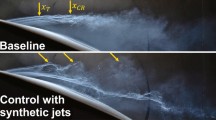Abstract
The star-shaped cross section of giant cylindrical cactus plants is thought to be aerodynamically favorable for protection against toppling by strong winds. Particle image velocimetry is used to investigate the flow details within the surface grooves and in the immediate wake of a cactus-inspired model cylinder with eight longitudinal grooves, at biologically relevant Reynolds numbers between 50 × 103 and 170 × 103. The wake flow is analyzed and compared to a similarly sized circular cylinder. At the lowest Re tested, the wakes from the two geometries are similar. At higher Re, the cactus wake exhibits superior behavior as seen from the mean and turbulent velocities, suggesting that the flow mechanisms are Re dependent. The flow within the surface grooves reveals counter rotating rollers, while the geometrical ridges act as vortex generators known to help with the surface flow attachment. Lastly, a simplistic analysis is described to recover, qualitatively, certain time-dependent flow features from the randomly acquired PIV realizations.
















Similar content being viewed by others
References
Abboud JE, Karaki WS, Oweis GF (2011). Particle image velocimetry measurements in the wake of a cactus-shaped cylinder. J Fluids Eng 133(9), art no. 094502
Amitay M, Smith BL, Glezer A (1998) Aerodynamic flow control using synthetic jet technology. 36th Aerospace Sciences Meeting and Exhibit, Reno, Nevada, Jan. 12–15
Apelt CJ, West GS, Szewczyk AA (1973) The effects of wake splitter plates on the flow past a circular cylinder in the range 104 < R < 5 × 104. J Fluid Mech 61(1):187–198
Babu P, Mahesh K (2008). Aerodynamic loads on cactus-shaped cylinders at low Reynolds numbers. Phys Fluids, vol 20, art no. 035112; doi:10.1063/1.2887982
Bearman PW, Harvey JK (1993) Control of circular cylinder flow by the use of dimples. AIAA J 31(10):1753–1756 188
Bushnell DM (1991) Drag reduction in nature. Ann Rev Fluid Mech 23:65–79
Cantwell B, Coles D (1983) An experimental study of entrainment and transport in the turbulent near wake of a circular cylinder. J Fluid Mech 136:321–374
Djeridi H, Braza M, Perrin R, Harran G, Cid E, Cazin S (2003) Near-wake turbulence properties around a circular cylinder at high Reynolds number. Flow Turbul Combust 71:19–34. doi:10.1023/B:APPL.0000014930.49408.53
Figliola RS, Beasley DE (2000). Theory and design of mechanical measurements. 3rd ed., Wiley: NY, pp 123–126. ISBN:0471350834
Geller GN, Nobel PS (1984) Cactus ribs: influence on PAR interception and CO2 uptake. Photosynthetica 18:482–494
Han D, Mungal MG (2003) Simultaneous measurements of velocity and CH distributions. Part 1: jet flames in co-flow. Combust Flame 132:565–590
Hodge C (1991) All about saguaros, Arizona Highways Publisher: Phoenix. ISBN:0916179605, 9780916179601
Huang S, Kitney N (2010). Model test on drag of cylinders with helical grooves at high Reynolds numbers. In: Proceedings AMSE 29th International Conference Ocean, Offshore & Arctic Eng OMAE2010, June 2010, Shanghai, China
Karaki W, Abboud J, Daher N, Osman M, Oweis G (2008). PIV Measurements in the Wake of a Cactus Shaped Cylinder. ASME 2008 International Mechanical Engineering Congress and Exposition (IMECE2008), Boston, Massachusetts, USA, http://dx.doi.org/10.1115/IMECE2008-67405
Kwon K, Choi H (1996) Control of laminar vortex shedding behind a circular cylinder using splitter plates. Phys Fluids 8(2):479–486
Lim HC, Lee SJ (2002) Flow control of circular cylinders with longitudinal grooved surfaces. AIAA J 40(10):2027–2036
Liu YZ, Shi LL, Yu J (2011) TR-PIV measurements of the wake behind a grooved cylinder at low Reynolds number. J Fluids Struct 27:394–407
Morgenthal G, Walther JH (2007) An immersed interface method for the vortex-in-cell algorithm. Comput Struct 85:712–726
Niklas KJ, Molina-Freaner F, Tinoco-Ojanguren C (1999) Biomechanics of the columnar cactus pachycereus pringlei. Am J Bot 86(6):767–775
Oweis GF, Ceccio SL (2005) Instantaneous and time averaged flow fields of multiple vortices in the tip region of a ducted propulsor. Exp Fluid 38(5):615–636
Owen JC, Bearman PW, Szewczyk AA (2001) Passive control of VIV with drag reduction. J Fluid Struct 15:597–605
Perrin R, Cid E, Cazin S, Sevrain A, Braza M, Moradei F, Harran G (2007) Phase-averaged measurements of the turbulence properties in the near wake of a circular cylinder at high Reynolds number by 2C-PIV and 3C-PIV”. Exp Fluid 42:93–109
Raffel M, Wilbert CE, Kompenhans (1998) Particle image velocimetry: a practical guide. Springer ISBN:9783540636830
Shukla S, Govardhan RN, Arakeri JH (2009) Flow over a cylinder with a hinged-splitter plate. J Fluid Struct 25:713–720
Talley S, Mungal G (2002) Flow around cactus-shaped cylinders center for turbulence research annual brief. NASA Ames/Stanford University, California, pp 363–376
Talley S, Iaccarino G, Mungal G, Mansur NN (2001) An experimental and computational investigation of flow past cacti. Annual Research Briefs Center for Turbulence Research, California, pp 51–64
Tu J, Miau J, Chou J, Lee G (2005). Sensing Flow Separation on a Circular Cylinder by MEMS Thermal-Film Sensors. 43rd AIAA Aerospace Sciences Meeting and Exhibit, Reno, Nevada, Jan. 10–13
White FM (2011) Fluid mechanics 7th Ed. (SI units). McGraw-Hill, NY, pp 236. ISBN 978-007-131121-2
Williamson CHK (1996) Vortex dynamics in the cylinder wake. Ann Rev Fluid Mech 28:477–539
Yamagishi Y, Oki M (2004) Effect of groove shape on flow characteristics around a circular cylinder with grooves. J Vis 7(3):209–216
Yamagishi Y, Oki M (2005) Effect of the number of grooves on flow characteristics around a circular cylinder with triangular grooves. J Vis 8(1):57–64
You D, Moin P (2007) Effects of hydrophobic surfaces on the drag and lift of a circular cylinder. Phys Fluids 19:08170
Acknowledgments
This work was supported by the University Research Board of the American University of Beirut.
Author information
Authors and Affiliations
Corresponding author
Rights and permissions
About this article
Cite this article
El-Makdah, A.M., Oweis, G.F. The flow past a cactus-inspired grooved cylinder. Exp Fluids 54, 1464 (2013). https://doi.org/10.1007/s00348-013-1464-z
Received:
Revised:
Accepted:
Published:
DOI: https://doi.org/10.1007/s00348-013-1464-z




